Interprovincial Differences in Air Pollution in the Background of China’s Carbon Neutrality Target
Abstract
:1. Introduction
2. Materials and Methods
2.1. Study Regions
2.2. Measurement of Total Carbon Emission
2.3. Measurement of Carbon Emission Intensity
2.4. Inverse Distance Weighting Interpolation Method
2.5. Data Sources
3. Results
3.1. Spatial and Temporal Variation of Pollutants
3.2. Temporal Variation of Carbon Emissions
3.3. Spatial Variation Patterns of Carbon Emissions
4. Discussion
4.1. Differences in Provincial Pollution Reduction
4.2. Differences in Provincial Carbon Emissions
4.3. Differences in Provincial Carbon Emission Intensities
5. Conclusions
Author Contributions
Funding
Data Availability Statement
Conflicts of Interest
References
- Murray, C.J.; Aravkin, A.Y.; Zheng, P.; Abbafati, C.; Abbas, K.M.; Abbasi-Kangevari, M.; Abd-Allah, F.; Abdelalim, A.; Abdollahi, M.; Abdollahpour, I.; et al. GBD 2019 Risk Factors Collaborators. Global burden of 87 risk factors in 204 countries and territories, 1990–2019: A systematic analysis for the Global Burden of Disease Study 2019. Lancet 2020, 396, 1223–1249. [Google Scholar] [CrossRef]
- Yang, X.; Teng, F.; Wang, G. Incorporating environmental co-benefits into climate policies: A regional study of the cement industry in China. Appl. Energy 2013, 112, 1446–1453. [Google Scholar] [CrossRef]
- Tian, Y.; Lin, Z.J. Spatial-temporal coupling relationship between agricultural carbon emissions and economic growth in the Yangtze River Economic Belt. J. China Agric. Univ. 2021, 26, 208–218. [Google Scholar]
- Zhang, Z.; Yu, Y.; Wang, D.; Kharrazi, A.; Ren, H.; Zhou, W.; Ma, T. Socio-economic drivers of rising CO2 emissions at the sectoral and sub-regional levels in the Yangtze River Economic Belt. J. Environ. Manag. 2021, 290, 112617. [Google Scholar] [CrossRef]
- Khairy, W.; Salem, M.; Saber, G. Analytical study of carbon dioxide equivalent emission from agricultural drain surfaces—A case study from Egypt. Irrig. Drain. 2021, 70, 719–731. [Google Scholar] [CrossRef]
- Blandford, D. We Should Focus on Food Consumption to Reduce Greenhouse Gas Emissions in Agriculture. EuroChoices 2021, 20, 18–22. [Google Scholar] [CrossRef]
- Ke, Y.Y. The Impact of Manufacturing Industrial Agglomeration on Urban Green Effect. Master’s Thesis, Shanghai University of Finance and Economics, Shanghai, China, 2020. [Google Scholar]
- Jiang, Z.R.; Jin, H.H.; Wang, C.J.; Ye, S.L.; Huang, Y.H. Carbon emission measurement and efficiency pattern of transportation in the Yangtze River Economic Belt. Environ. Sci. 2020, 41, 2972–2980. [Google Scholar]
- Katz-Rosene, R.M. A not-so-green choice? The high carbon footprint of long-distance passenger rail travel in Canada. Can. Geogr. Géographe Can. 2021, 65, 141–151. [Google Scholar] [CrossRef]
- Wang, Z.Y.; Wang, Z.F. Study on the spatial and temporal evolution and influencing factors of tourism industry efficiency under carbon emission constraint in the Yangtze River Economic Belt. Resour. Environ. Yangtze Basin 2021, 30, 280–289. [Google Scholar]
- Greening, L.A.; Ting, M.; Davis, W.B. Decomposition of aggregate carbon intensity for freight: Trends from 10 OECD countries for the period 1971–1993. Energy Econ. 1999, 21, 331–361. [Google Scholar] [CrossRef]
- Xia, S.Y.; Zhao, Y.; Xu, X.; Wen, Q.; Cui, P.P.; Tang, W.M. Regional differences, temporal and spatial patterns and dynamic evolution of agricultural carbon emission intensity in China in recent 20 years. Resour. Environ. Yangtze Basin 2020, 29, 596–608. [Google Scholar]
- Han, M.Y.; Liu, W.D.; Xie, Y.T.; Jiang, W.B. Regional differences and decoupling trend of carbon emissions in China. Resour. Sci. 2021, 43, 710–721. [Google Scholar]
- Qiang, W.; Han, X.Y.; Li, R.R. Does technical progress curb India’s carbon emissions? A novel approach of combining extended index decomposition analysis and production-theoretical decomposition analysis. Environ. Manag. 2022, 310, 114720. [Google Scholar]
- Zhu, X.-J.; Zhang, H.-Q.; Gao, Y.-N.; Yin, H.; Chen, Z.; Zhao, T.-H. Assessing the regional carbon sink with its forming processes—A case study of Liaoning province, China. Sci. Rep. 2018, 8, 15161. [Google Scholar] [CrossRef] [PubMed] [Green Version]
- Ghaffar, A.; Nathsuda, P.; Cui, S.H. Valuation and validation of carbon sources and sinks through land cover/use change analysis: The case of Bangkok metropolitan area. Land Use Policy 2018, 70, 471–478. [Google Scholar]
- Wu, J.Y.; Mao, Q.Q.; Dong, B.C. Research on the sustainable development of personal carbon accounts in the era of big data—Take Ant Financial as an example. Times Financ. 2019, 14, 103–107+111. [Google Scholar]
- Yu, B.L. Research on Greenhouse Gas, Haze Pollution Reduction Strategy and Synergistic Reduction Effect; China University of Mining and Technology: Beijing, China, 2019. [Google Scholar]
- Ministry of Ecology and Environment of the People’s Republic of China. Communiqué on the State of Ecological Environment in China. 2014–2019:7–9. Available online: https://www.mee.gov.cn/hjzl/sthjzk/zghjzkgb/ (accessed on 19 April 2022).
- Liu, Y.W.; Yang, C.; Cai, H.Y. Inter-provincial differences and factor decomposition of total carbon emissions and intensity in China. J. Hunan Univ. Technol. 2022, 36, 1–9. [Google Scholar]
- IPCC. Climate Change 2007: Mitigation: Contribution of Working Group III to the Fourth Assessment Report of the Intergovernmental Panel on Climate Change; Cambridge University Press: Cambridge, UK, 2007. [Google Scholar]
- IPCC. Climate Change 2001: Mitigation: Contribution of Working Group III to the Third Assessment Report of the Intergovernmental Panel on Climate Change; Cambridge University Press: Cambridge, UK, 2001. [Google Scholar]
- IPCC. Climate Change 2014: Mitigation of Climate Change: Contribution of Working Group III to the Fifth Assessment Report of the Intergovernmental Panel on Climate Change; Cambridge Un2 strengthening the global response to the threat of climate change, sustainable development, and efforts to eradicate poverty; Cambridge University Press: Cambridge, UK, 2018. [Google Scholar]
- Zhu, Q.A.; Zhang, W.C.; Yu, J.H. Research on spatial interpolation method based on GIS. J. Jiangxi Norm. Univ. 2004, 2, 183–188. [Google Scholar]
- Carbon Emission Accounts Datasets, China Energy Inventory1997–2019 and Energy Emission Inventory of 30 Provincial Administrative Regions 2010–2019. Available online: https://www.ceads.net.cn/data/nation/ (accessed on 20 March 2021).
- National Bureau of Statistics, Statistical Yearbook 2009–2019. Available online: https://data.stats.gov.cn/easyquery.htm?cn=C01 (accessed on 20 March 2021).
- Ministry of Ecology and Environment of the People’s Republic of China. Communiqué on the State of Ecological Environment in China 2012–2019. Available online: https://www.mee.gov.cn/hjzl/sthjzk/zghjzkgb/ (accessed on 20 March 2021).
- Central People’s Government of the People’s Republic of China. Thirteenth Five-Year Plan for Ecological Environmental Protection. Available online: http://www.gov.cn/xinwen/2016-12/05/content_5143464.htm (accessed on 19 April 2022).
- MEE. Ambient Air Quality Standards (GB 3095-2012) [Z]//CHINA M O E A E O T P S R O. Available online: https://www.mee.gov.cn/ywgz/fgbz/bz/bzwb/dqhjbh/dqhjzlbz/201203/t20120302_224165.shtml (accessed on 19 April 2022).
- Wang, F.Y. Health Effects of PM2.5 and O3 Air Pollution in Beijing-Tianjin-Hebei Region and the Reduction Response to Pollutants; North China Electric Power University: Beijing, China, 2021. [Google Scholar]
- Guo, X.P.; Song, H.K.; Liang, L.K.; Liu, P.F. Characteristics of spatial and temporal variation of ozone concentration in China from 2015–2017. Meteorol. Environ. Sci. 2020, 43, 41–50. [Google Scholar]
- Song, J.K.; Jiang, L.N.; Zhao, Z.H.; Zhang, Y.M.; Lv, G.T. Cointegration test of the relationship between energy consumption, air pollutant emissions and carbon intensity in China--based on data from 2000 to 2017. Environ. Prot. Sci. 2020, 46, 1–7. [Google Scholar]
- Xi, Y.L. Study on the synergistic reduction effect of greenhouse gases and air pollutants in Beijing-Tianjin-Hebei region. City 2021, 10, 49–61. [Google Scholar]
- Liu, Q.; Wang, S.; Zhang, W.; Li, J.; Kong, Y. Examining the effects of income inequality on CO2 emissions: Evidence from non-spatial and spatial perspectives. Appl. Energy 2018, 236, 163–171. [Google Scholar] [CrossRef]
- Gao, D.; Kong, G.; Ma, L.W.; Yan, X.H.; Zhang, H. Study on the current situation of regional energy and the focus of medium and long-term development strategies in China. China Eng. Sci. 2021, 23, 7–14. [Google Scholar] [CrossRef]
- Peters, G.P.; Andrew, R.M.; Boden, T.; Canadell, J.G.; Ciais, P.; Quere, C.L.; Marland, G.; Raupach, M.R.; Wilson, C. The challenge to keep global warming below 2 °C. Nat. Clim. Chang. 2012, 3, 4–6. [Google Scholar] [CrossRef]
- Gao, Z.F. Yangtze River Delta Urban Agglomeration of Carbon Emissions and Atmospheric Pollution Emissions of Collaborative Governance Research; Zhejiang University of Technology: Zhejiang, China, 2019. [Google Scholar]
- Mongabay Report “China Overtakes US as Top CO2 Emitter” 17 October 2007. Available online: https://cn.mongabay.com/ (accessed on 20 March 2021).
- Shi, H.D.; Gao, Q.X.; Zhang, S.H.; Chen, D.S.; Du, W.P.; Fu, J.F.; Bai, H.M. A Review of Research on Air Pollution Impacts and Feedbacks on Climate Change. Res. Environ. Sci. 2012, 25, 974–980. [Google Scholar]
- Wang, Z.H.; Yan, L. Indirect carbon emissions in household consumption: Evidence from the urban and rural area in China. J. Clean. Prod. 2014, 78, 94–103. [Google Scholar] [CrossRef]
- Zhao, L.Y.; Feng, L.Y. Research on energy efficiency and influencing factors in Inner Mongolia based on DEA model. J. Inn. Mong. Univ. Financ. Econ. 2017, 15, 32–35. [Google Scholar]
- Tian, D.Y.; Wang, Y. Research report on low-carbon development in Inner Mongolia and Ningxia Hui Autonomous Region. China Econ. Trade J. 2020, 2, 124–125. [Google Scholar]
- Wang, Z.H. Research on Temporal and Spatial Evolution Characteristics and Influencing Factors of Regional Carbon Emissions; Shandong Normal University: Shandong, China, 2021. [Google Scholar]
- Tian, Z.; Zhang, H.Y.; Niu, W.J. The Yangtze river economic belt of carbon emissions peak forecast and mitigation strategies. J. Resour. Ind. 2021, 23, 97–105. [Google Scholar]
- Liu, X.J. Spatial and Temporal Characteristics and Driving Factors of PM2.5 Pollution in the Yangtze River Economic Belt; Lanzhou University: Lanzhou, China, 2021. [Google Scholar]
- Qin, Y.Q. Temporal and Spatial Evolution Characteristics of Main Pollutant Emissions in the Yangtze River Economic Belt; Nanjing University: Nanjing, China, 2019. [Google Scholar]
- Wang, Y.X.; Yu, X.H.; Xiong, X. Study on spatial difference and influencing factors of pollutant emission intensity in the Yangtze river economic belt. West Forum 2019, 29, 104–114. [Google Scholar]
- Huang, C.; Chen, C.H.; Li, L.; Cheng, Z.; Wang, H.L.; Wang, Y.J.; Huang, H.Y.; Zhang, G.F.; Chen, Y.R. Characteristics of anthropogenic atmospheric pollutants in the Yangtze River Delta. J. Environ. Sci. 2011, 31, 1858–1871. [Google Scholar]

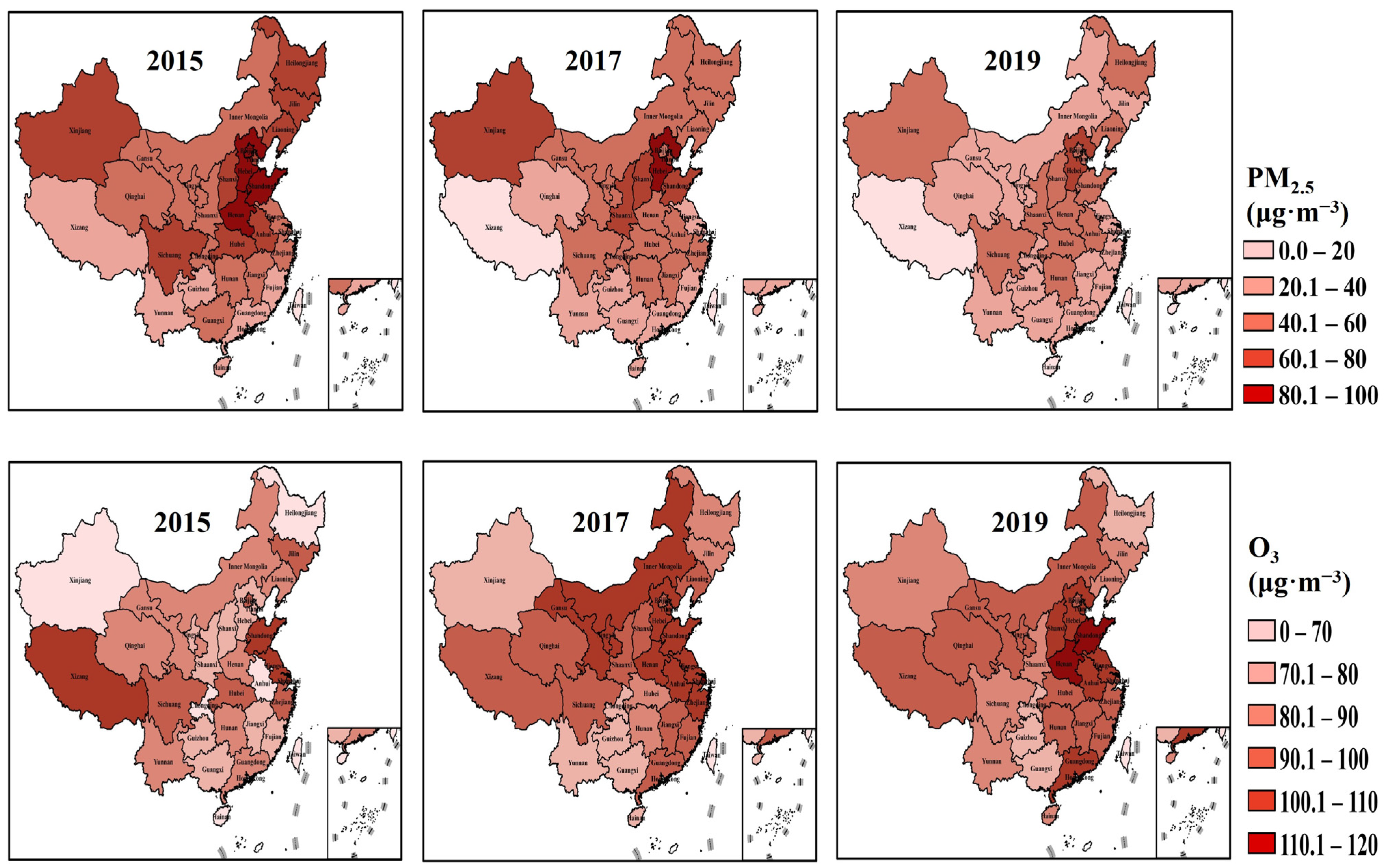
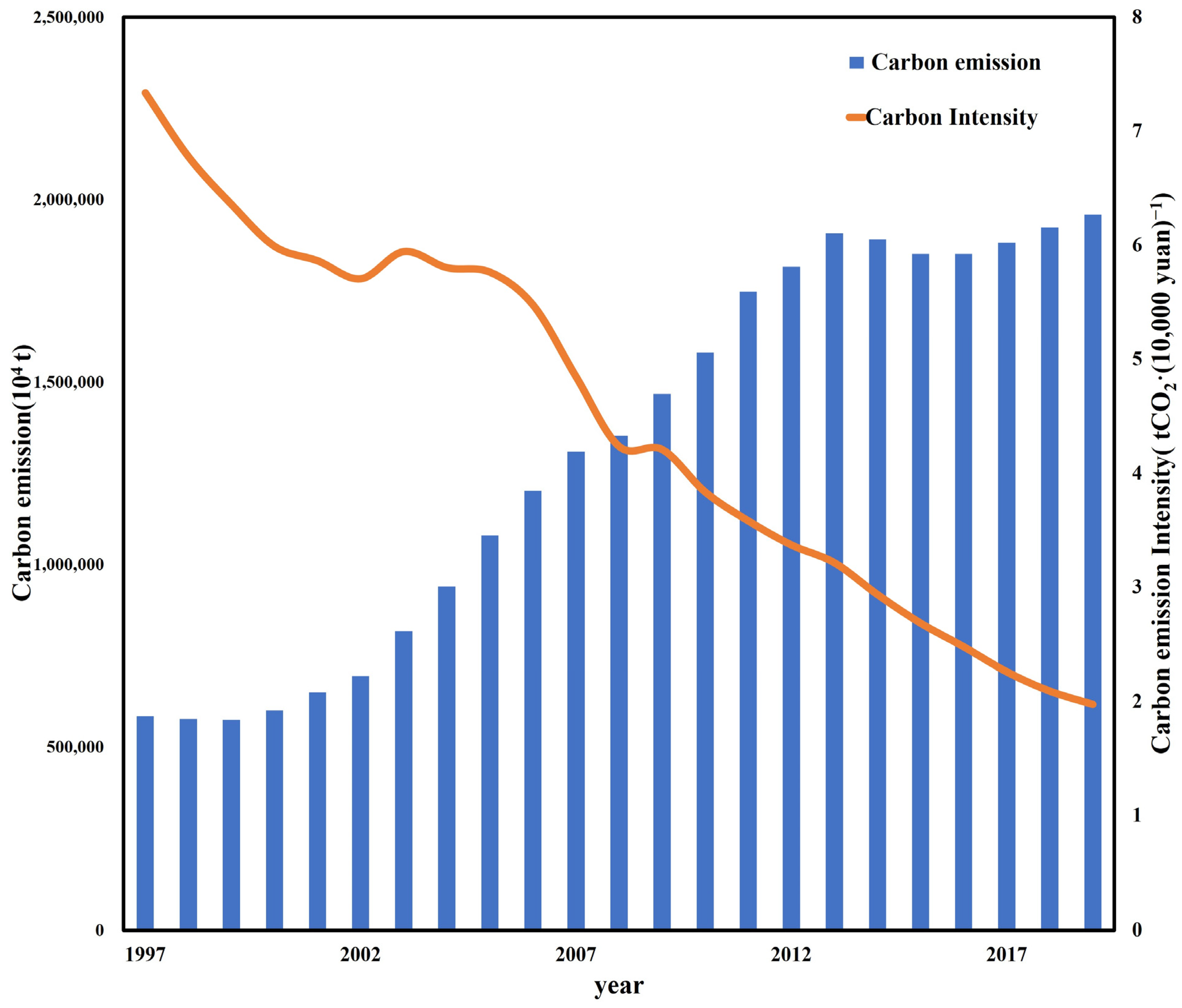
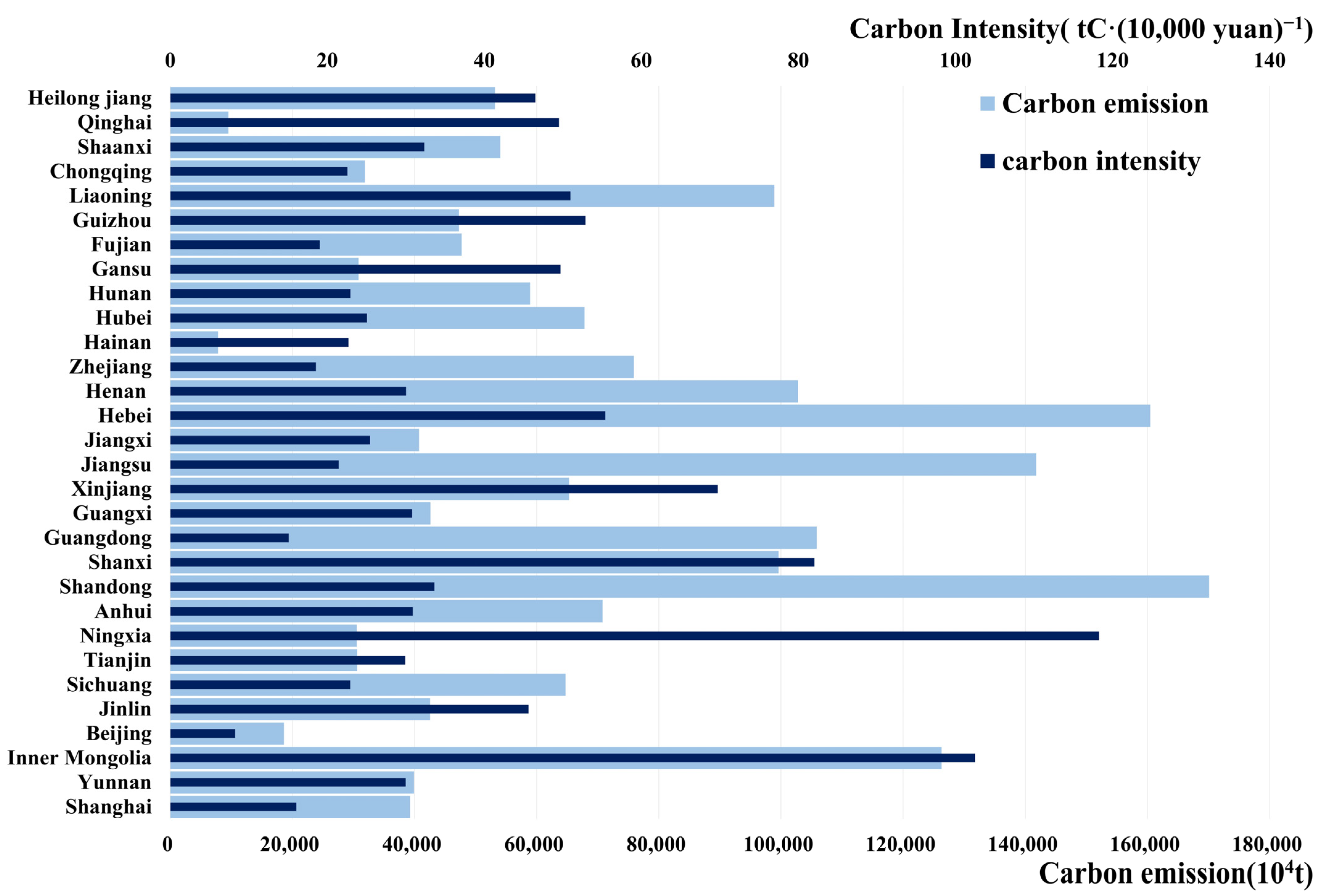
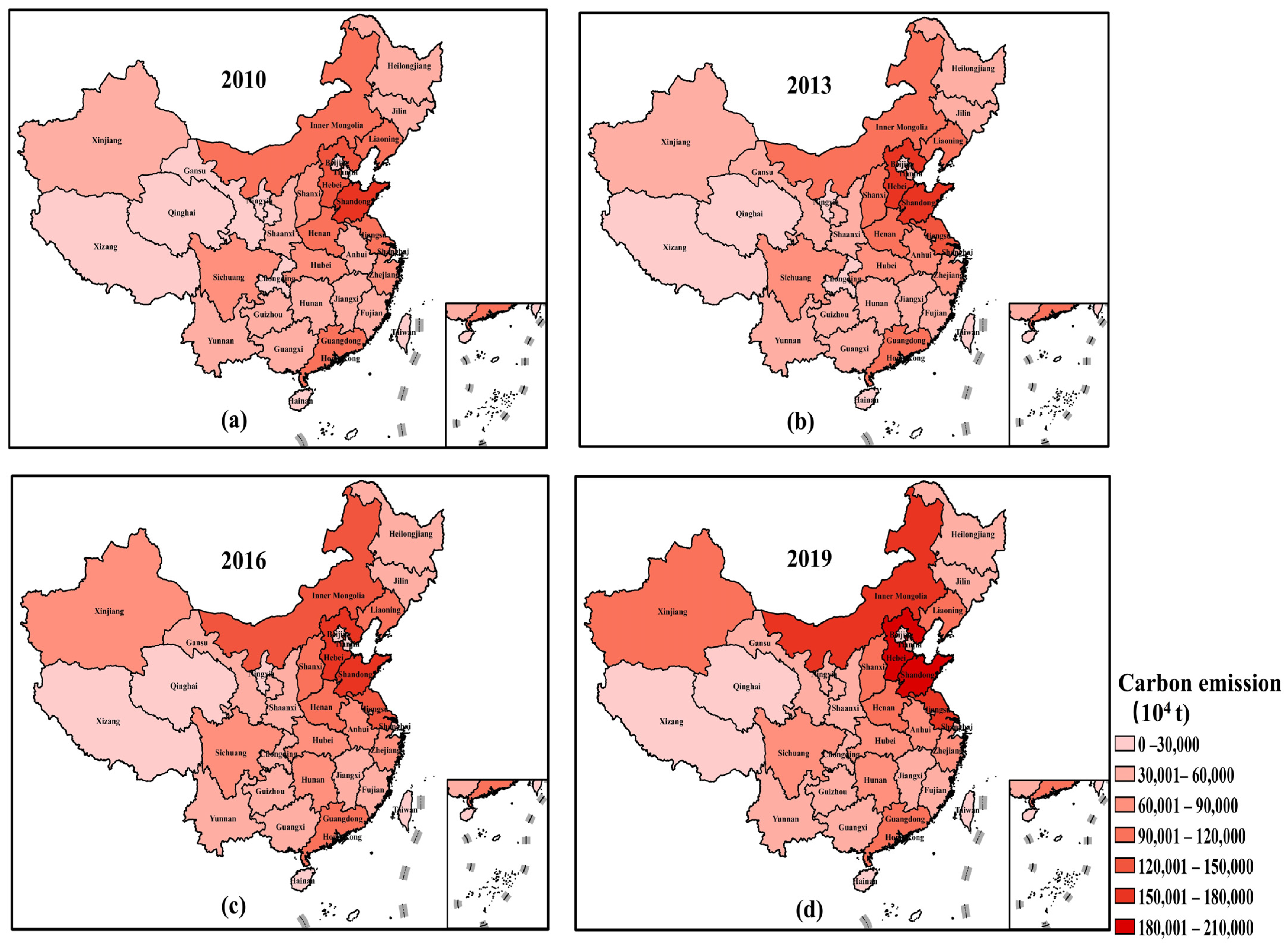
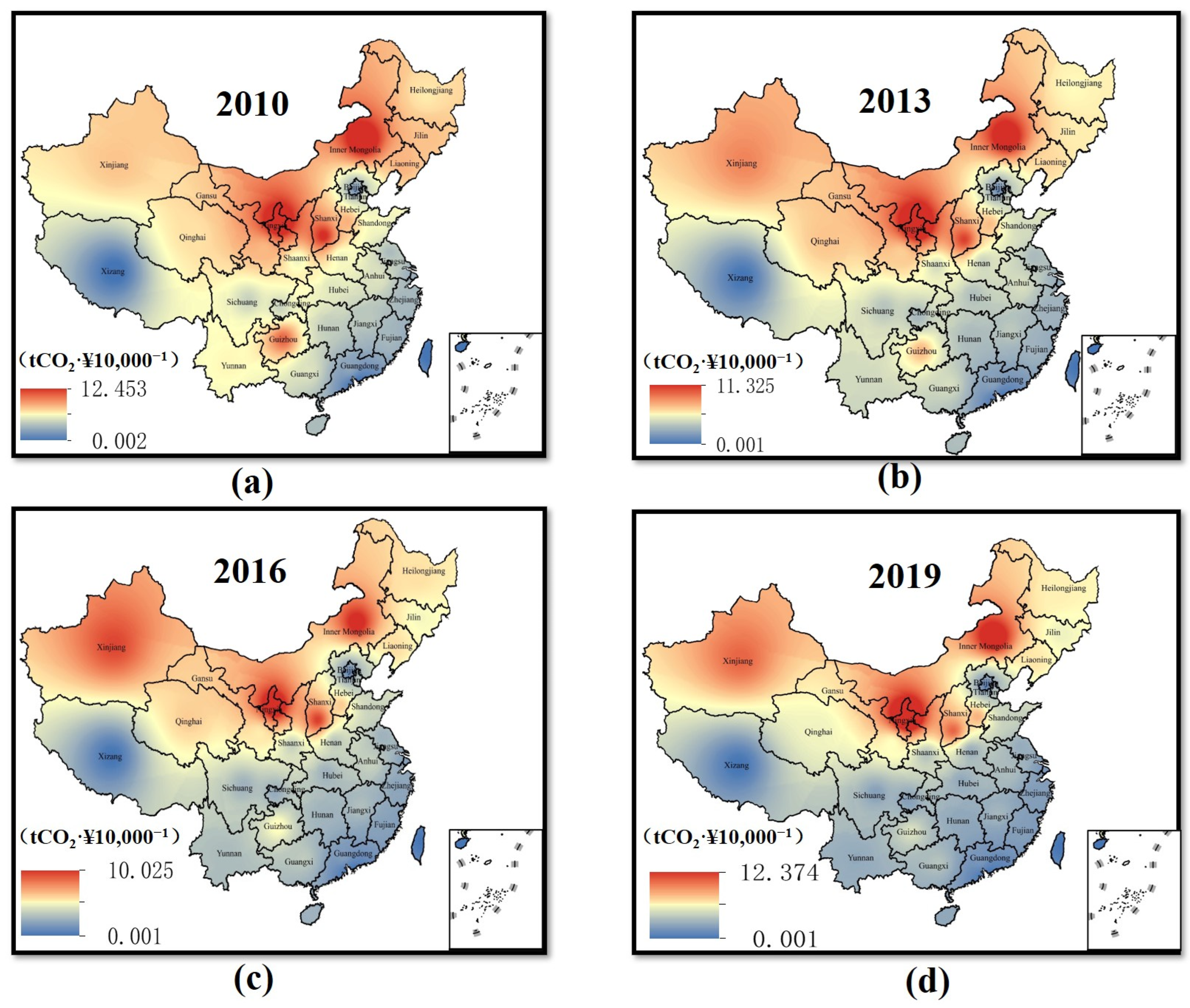
| Provincial Districts | Total Carbon Emissions | Carbon Emission Intensity | PM2.5 Reductions | O3 Reductions | ||||
|---|---|---|---|---|---|---|---|---|
| Mean (10,000 Tons) | Rank | Mean (Tons·¥10,000−1) | Rank | Mean (μg·m−3) | Rank | Mean (μg·m−3) | Rank | |
| Shanghai | 39,290.400 | 23 | 1.605 | 28 | 0.086 | 15 | −0.007 | 25 |
| Yunnan | 39,905.000 | 22 | 2.999 | 17 | 0.045 | 20 | 0.025 | 22 |
| Inner Mongolia | 126,317.100 | 4 | 10.248 | 2 | 0.000 | 23 | 0.049 | 17 |
| Beijing | 18,610.800 | 28 | 0.827 | 29 | 0.095 | 14 | 0.089 | 6 |
| Jilin | 42,554.900 | 20 | 4.563 | 11 | 0.031 | 22 | 0.047 | 18 |
| Sichuan | 64,728.800 | 13 | 2.291 | 22 | 0.099 | 13 | −0.007 | 26 |
| Tianjin | 30,632.300 | 26 | 2.992 | 18 | 0.059 | 18 | 0.050 | 16 |
| Ningxia | 30,539.300 | 27 | 11.827 | 1 | −0.031 | 27 | 0.021 | 23 |
| Anhui | 70,776.900 | 10 | 3.088 | 14 | 0.152 | 7 | 0.103 | 5 |
| Shanxi | 99,589.000 | 7 | 8.205 | 3 | 0.083 | 16 | 0.061 | 13 |
| Shandong | 170,098.2 | 1 | 3.363 | 12 | 0.080 | 17 | 0.075 | 10 |
| Guangdong | 105,851.100 | 5 | 1.509 | 30 | 0.185 | 5 | 0.127 | 2 |
| Guangxi | 42,606.200 | 19 | 3.080 | 15 | 0.235 | 2 | 0.164 | 1 |
| Xinjiang | 65,285.800 | 12 | 6.973 | 4 | 0.000 | 24 | 0.000 | 24 |
| Jiangsu | 141,792.000 | 3 | 2.145 | 25 | 0.116 | 11 | 0.052 | 15 |
| Jiangxi | 40,732.200 | 21 | 2.544 | 19 | 0.143 | 8 | 0.086 | 7 |
| Hebei | 160,470.500 | 2 | 5.541 | 5 | 0.108 | 12 | 0.084 | 8 |
| Henan | 102,777.600 | 6 | 3.004 | 16 | / | / | / | / |
| Zhejiang | 75,880.000 | 9 | 1.855 | 27 | 0.194 | 3 | 0.058 | 14 |
| Hainan | 7817.400 | 30 | 2.269 | 23 | 0.188 | 4 | 0.110 | 4 |
| Hubei | 67,834.100 | 11 | 2.506 | 20 | 0.167 | 6 | 0.120 | 3 |
| Hunan | 58,920.800 | 14 | 2.294 | 21 | / | / | / | / |
| Gansu | 30,822.600 | 25 | 4.970 | 8 | 0.000 | 25 | −0.031 | 27 |
| Fujian | 47,706.200 | 17 | 1.903 | 26 | 0.143 | 9 | 0.068 | 11 |
| Guizhou | 47,275.400 | 18 | 5.288 | 6 | 0.421 | 1 | 0.068 | 12 |
| Liaoning | 98,918.100 | 8 | 5.095 | 7 | 0.050 | 19 | 0.033 | 21 |
| Chongqing | 31,877.400 | 24 | 2.256 | 24 | 0.132 | 10 | 0.045 | 19 |
| Shaanxi | 54,057.800 | 15 | 3.235 | 13 | −1.389 | 28 | 0.039 | 20 |
| Qinghai | 9517.700 | 29 | 4.951 | 9 | 0.045 | 21 | 0.082 | 9 |
| Heilongjiang | 53,155.900 | 16 | 4.650 | 10 | 0.000 | 26 | −0.039 | 28 |
Publisher’s Note: MDPI stays neutral with regard to jurisdictional claims in published maps and institutional affiliations. |
© 2022 by the authors. Licensee MDPI, Basel, Switzerland. This article is an open access article distributed under the terms and conditions of the Creative Commons Attribution (CC BY) license (https://creativecommons.org/licenses/by/4.0/).
Share and Cite
Zou, Q.; Zhao, J.; Sun, Y.; He, C.; Zhang, Z. Interprovincial Differences in Air Pollution in the Background of China’s Carbon Neutrality Target. Sustainability 2022, 14, 6200. https://doi.org/10.3390/su14106200
Zou Q, Zhao J, Sun Y, He C, Zhang Z. Interprovincial Differences in Air Pollution in the Background of China’s Carbon Neutrality Target. Sustainability. 2022; 14(10):6200. https://doi.org/10.3390/su14106200
Chicago/Turabian StyleZou, Qi, Jinhui Zhao, Yingying Sun, Chao He, and Zhouxiang Zhang. 2022. "Interprovincial Differences in Air Pollution in the Background of China’s Carbon Neutrality Target" Sustainability 14, no. 10: 6200. https://doi.org/10.3390/su14106200
APA StyleZou, Q., Zhao, J., Sun, Y., He, C., & Zhang, Z. (2022). Interprovincial Differences in Air Pollution in the Background of China’s Carbon Neutrality Target. Sustainability, 14(10), 6200. https://doi.org/10.3390/su14106200





